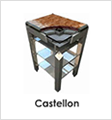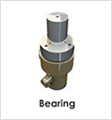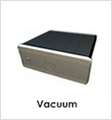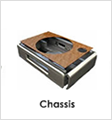

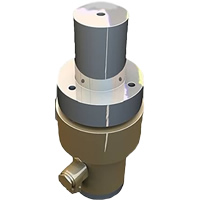
Caliburn Bearing |
Caliburn Bearing
A World First
Caliburn uses a world first turntable bearing engineering design.
In pursuit of the ultimate bearing for the Caliburn, we evaluated all respected bearing design alternatives, and proto-typed several Caliburn platter/bearing combinations.
The Caliburn Bearing has been chosen for its ultimate musicality.
THe Caliburn bearing operates on a hydrostatic principle where oil provides the interface between bearing surfaces for ultra-low friction and high damping.
Due to the superior damping over comparable air bearing systems, this principle is preferred in ultra-precision tooling machines used to manufacture aerospace components and optical systems.
Vacuum Hold Down
Prior art using vacuum required special pumps to be isolated into adjacent rooms or held in cumbersome cabinets to minimize playback noise.
Additionally, pulsing vibration caused by pumps had to be countered with lengthy hoses and adjustment mechanisms.
The pump pressure using “lossy” bearing designs also meant the spindle shape and size were influenced.
So the advantages of vacuum hold down were being held back by engineering challenges.
Alternate gravity based heavy metal rings that are placed around the LP once it has been put on the platter were in our opinion seriously flawed, as they can never be balanced and if they dislodge during playback the potential for serious damage to expensive cartridge arm combinations let alone the underlying turntable is high.
It features a fully sealed vacuum rotary feedthrough, which allows for the LP to be held down under vacuum without the pump having to run during extended playback.
Research and Design
We researched the nuclear and high tech industries to evaluate magnetic ferrofluid seals for rotary feedthrough but these devices were not viable due to the size and assembly requirements.
Our engineers then went back to the drawing board and designed a miniature rotary seal, which creates a vacuum tight low-friction seal in a size not much bigger than a roll of 35mm film.
This option for sealing allows for vacuum pressure to be held whilst the turntable is in operation without the pump running.
Sensors and complex computer logic monitors the pressure and delivers additional vacuum in controlled “doses” to maintain the hold down.
The pressure settings are very low, as the bearing does not lose pressure during playback.
Pulsing vibration is also removed as the system is quiet – “there’s no pump like NO PUMP!”
Bearing Design
The thickness of the bearing shaft also has a critical effect on the resonance of the platter and we have optimized this to keep all the wobble resonances below 10Hz.
The relationship between platter mass and the spindle diameter is critical to the resonance of the platter and we recognise this fact is understood by a handful of turntable designers.
Other features include the use of a ball/thrust pad configuration for vertical motion, and bronze alloy for the axial motion.
The bronze alloy contains higher than normal tin compounds, which fill any micro asperities in the shaft over time to create an ultra silent bearing.
We chose not to use magnetic vertical bearings as the VTA is constantly changing due to the rotational effects of the platter, which results in a loss of depth and soundstage.
Oils Ain’t Oils
Bearing design is not just about how fine the tolerances are or how accurate your CNC process is.
Continuum Audio Laboratories researched the oils used in bearings and worked with tribologists to arrive at a formulation, which “sounds” better than any other oil we have tried.
The reason for this is under pressure different oils exhibit different responses. We required an oil that didn’t outgas (evaporate), remained stable under extreme pressure and worked with the design of the bearing to minimize precession (or “wobble”).
The Audiophile Result
The audiophile result was a bearing that solved the ergonomic issues of a vacuum holddown design and created the most silent bearing/pump combination yet realised in analogue playback.
This breakthrough in engineering has resulted in a significant improvement in micro detail, tonal accuracy and timbre, focus and musicality.
Ease of use and computer controlled and adjustable logic ensure that no skills are required to operate the turntable other than on and off and speed selection.
The user cannot over pressure or create an environment which harms the LP.
|


